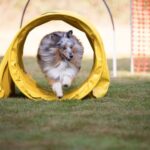Have you ever wondered how to train your dog to find moles? Understanding the behavior of moles and why it’s essential to enlist your furry friend in this task can lead to a successful mole detection partnership. Moles can cause damage to your yard by creating unsightly tunnels, making it crucial to have a proactive approach in managing them.
Dogs have natural instincts and abilities that make them excellent hunters, especially when it comes to tracking down small creatures like moles. Their keen sense of smell and sharp hearing contribute to their effectiveness in sniffing out these elusive pests. By harnessing your dog’s innate talents, you can create a harmonious relationship where they assist in keeping your outdoor space mole-free.
Choosing the right dog breed for mole detection is key to ensure success in this endeavor. Certain breeds are more suited for this specific task due to their hunting instincts and high energy levels. In the following sections, we will delve into the best dog breeds for mole detection, discussing their characteristics and how they can excel in helping you tackle the mole problem in your yard.
Why Use Dogs for Mole Detection
Dogs have long been known for their exceptional sense of smell and keen hunting instincts, making them excellent candidates for mole detection. Their ability to pick up scents undetectable to the human nose, combined with their natural inclination to track and dig, makes them ideal for this task. By understanding how to tap into these inherent qualities, you can effectively train your dog to find moles in your yard or garden.
One key advantage of using dogs for mole detection is their proficiency in locating tunnels and burrows underground. Moles create intricate networks of tunnels as they forage for food, leaving behind a distinct scent trail that dogs can easily pick up on. Additionally, dogs have a strong prey drive that motivates them to track down elusive creatures like moles, making the training process more engaging and rewarding for them.
When selecting a dog breed for mole detection, it’s essential to consider characteristics such as high energy levels, good scenting ability, and a strong desire to hunt. Breeds like Terriers, Dachshunds, Jack Russell Terriers, and Beagles are known for their hunting prowess and make excellent choices for detecting moles. These breeds are typically eager to please their owners and quick learners, making them well-suited for the specific tasks involved in mole detection training.
| Characteristics | Relevant Breed(s) |
|---|---|
| High energy levels | Terriers (e.g. Jack Russell Terriers) |
| Good scenting ability | Dachshunds |
| A strong desire to hunt | Beagles |
Choosing the Right Dog Breed for Mole Detection
When it comes to training your dog to find moles, choosing the right breed can make a significant difference in the success of your efforts. Some dog breeds have natural instincts and abilities that make them better suited for mole detection than others. Understanding the characteristics of these breeds can help you select the most appropriate partner for this specific task.
Terriers: Natural Born Mole Hunters
Terrier breeds such as Jack Russell Terriers, Rat Terriers, and Border Terriers are known for their strong hunting instincts and tenacity when it comes to rooting out small prey like moles. These dogs were originally bred for vermin control, making them excellent candidates for mole detection work. Their high energy levels and drive to hunt make them eager to search for moles in your yard.
Dachshunds: Small but Mighty
Dachshunds may be small in size, but they have big personalities and a keen sense of smell that makes them effective mole detectors. Their low-to-the-ground stature and ability to burrow into tunnels make them well-equipped for locating moles underground. Dachshunds are also known for being persistent and fearless when it comes to tracking down their prey.
Labs and Retrievers: Versatile Detection Dogs
Labrador Retrievers and Golden Retrievers are popular choices for various types of detection work, including finding moles. These breeds are intelligent, obedient, and have an excellent sense of smell, which is essential for locating hidden pests like moles. Labs and Retrievers are quick learners, making them ideal candidates for training exercises on how to train your dog to find moles.
By choosing a dog breed with natural hunting instincts and the right characteristics for mole detection, you’ll be setting yourself up for success in training your furry companion to help keep your yard free of unwanted intruders. Each breed has its unique strengths and qualities that can enhance their ability to excel in this specialized task of finding moles.
With the right breed by your side, you’ll be on your way to effectively training your dog to detect moles in no time.
Basic Training Techniques
Introduction to Basic Training Techniques
Training your dog to find moles can be a rewarding and valuable skill that not only helps in pest control but also strengthens the bond between you and your furry companion. Basic training techniques are essential in laying the foundation for your dog’s ability to recognize and alert you to the presence of moles in your yard or garden.
By following a step-by-step guide, you can effectively teach your dog how to utilize their natural instincts for this purpose.
Building a Foundation
Before diving into specific mole detection training exercises, it is crucial to establish a strong foundation with basic obedience training. Commands such as “sit,” “stay,” and “come” are essential for effective communication between you and your dog during mole detection sessions. Consistency, patience, and positive reinforcement are key elements in this process to ensure that your dog understands what is expected of them.
Introducing the Scent of Moles
One of the first steps in training your dog to find moles is introducing them to the scent of moles. You can do this by obtaining a mole scent sample or using alternative methods such as manufactured scents designed for tracking purposes. Start by allowing your dog to sniff the scent while associating it with positive reinforcement, such as treats or toys.
Gradually increase the exposure to the scent and encourage your dog to investigate and alert you when they detect it. Consistent practice will help reinforce their ability to recognize the scent of moles accurately.
Advanced Training Methods
Once your dog has mastered the basic training techniques for mole detection, it’s time to take their skills to the next level with more advanced training methods. These exercises will challenge your dog and help them become even more proficient at finding moles in your yard or garden.
To enhance your dog’s mole detection skills, consider incorporating the following advanced training techniques into their routine:
- Scent discrimination drills: Create a lineup of different containers, each containing a distinct scent. Train your dog to identify and alert you to the container that contains the mole scent. This exercise will sharpen your dog’s ability to differentiate between various scents and focus specifically on detecting moles.
- Distraction training: Introduce distractions during your training sessions, such as noises or other animals in the vicinity. Teach your dog to stay focused on finding moles despite these distractions. This will help improve their concentration and ensure they remain focused on the task at hand.
- Increase search area complexity: Gradually expand the search area for your dog to cover larger areas with varying terrain and obstacles. This will challenge your dog to navigate different environments while continuing to locate moles effectively.
By incorporating these advanced training methods into your dog’s routine, you can further enhance their mole detection skills and prepare them for real-life scenarios where they may need to find moles in challenging conditions. Consistent practice and patience are key factors in developing a highly skilled mole-hunting canine companion.
Remember that each dog progresses at its own pace, so be patient and provide positive reinforcement throughout the training process. With dedication and perseverance, you can train your dog to become a reliable mole detector in no time.
Practice Drills and Exercises
Dogs have an incredible sense of smell, making them natural hunters when it comes to tracking down moles. To effectively train your dog to find moles, it is essential to create realistic scenarios that mimic the conditions they will encounter in the field. By engaging in practice drills and exercises, you can help your furry companion hone their mole-finding abilities and become a valuable asset in controlling these critters in your yard or garden.
Here are some practice drills and exercises you can incorporate into your training regimen:
- Scent Recognition: Introduce your dog to the scent of a mole by using scented objects or soil from areas where moles are present. Allow your dog to sniff these items and associate the scent with a positive experience, such as playtime or treats.
- Hide and Seek: Start with simple hide-and-seek games where you hide a scented object or treat for your dog to find. Gradually increase the difficulty level by hiding these items in more challenging locations, such as under bushes or behind obstacles.
- Mock Mole Burrows: Create simulated mole tunnels using PVC pipes or similar materials buried under the ground. Place scented objects at the end of these tunnels for your dog to locate, encouraging them to use their natural digging instincts.
By regularly engaging in these practice drills and exercises, you can strengthen your dog’s ability to detect moles and alert you to their presence effectively. Consistent training sessions will help reinforce their skills and ensure they are well-prepared for real-life situations where mole detection is needed. Remember to keep training sessions fun and rewarding for your canine companion to maintain their motivation and enthusiasm for the task at hand.
Troubleshooting Common Issues
When training your dog to find moles, there may be various challenges that you encounter along the way. One common issue is when your dog lacks motivation or interest in mole detection. This could be due to distractions in the environment, lack of proper training reinforcement, or simply a disinterest in the task at hand.
To overcome this challenge, it’s important to make training sessions fun and engaging for your dog. Incorporating their favorite toys or treats as rewards can help increase their motivation and enthusiasm for finding moles.
Another potential challenge during the training process is when your dog exhibits fear or hesitation towards digging or approaching areas where moles may be present. This could be triggered by unfamiliar scents, sounds, or textures in the soil that may unsettle your dog. In such cases, it’s essential to desensitize your dog to these stimuli gradually.
Start by introducing them to mole-scented objects or utilizing positive reinforcement techniques when they display non-fearful behavior around burrow sites. Over time, with patience and consistency, your dog can become more comfortable and confident in detecting moles.
Additionally, some dogs may struggle with maintaining focus and alertness during mole detection training sessions. They may get easily distracted by other scents, noises, or movements in the surroundings, making it challenging for them to stay on track with finding moles. To address this issue, consider implementing short but frequent training sessions to keep your dog engaged and focused.
Use visual cues or signals to guide them towards mole activity areas and practice gradually increasing their attention span through gradual exposure and repetition. With persistence and positive reinforcement techniques, you can help improve your dog’s focus and sharpen their mole detection skills over time.
Rewards and Reinforcement
Rewarding and reinforcing your dog’s behavior is crucial when training them to find moles. Positive reinforcement is a powerful tool that motivates your furry friend to continue exhibiting the desired behavior, in this case, detecting moles. By rewarding your dog with treats, praise, or playtime whenever they successfully identify a mole, you are reinforcing the connection between their actions and positive outcomes.
Consistency is key when it comes to rewards and reinforcement during mole detection training. Make sure to reward your dog every time they correctly alert you to the presence of moles, even if it’s just during practice drills. This will help build a strong association between detecting moles and receiving rewards, encouraging them to keep up the good work.
In addition to treats and praise, using toys or activities as rewards can also be effective in training your dog to find moles. For example, allowing them extra playtime with their favorite toy after a successful mole detection session can further enhance their motivation. Remember that every dog is unique, so pay attention to what type of reward works best for your furry companion during training on how to train your dog to find moles.
| Rewards | Reinforcement |
|---|---|
| Treats | Praise |
| Playtime | Toys |
Conclusion
In conclusion, training your dog to find moles can be a rewarding and beneficial activity for both you and your furry companion. By understanding the behavior of moles and the importance of controlling their presence in your yard or garden, you can see the value of having a skilled mole detection dog by your side. Dogs are naturally equipped with keen senses and instincts that make them excellent hunters, making them perfect candidates for this specific task.
When it comes to choosing the right dog breed for mole detection, it’s essential to consider characteristics like intelligence, energy level, and working drive. Breeds like terriers, dachshunds, and beagles are often recommended for their natural hunting abilities and willingness to work alongside their owners. With the right breed selected, you can then move on to basic training techniques outlined in this article on how to train your dog to recognize and alert you to the presence of moles.
As you embark on this training journey with your canine companion, remember to be patient, consistent, and positive in your approach. Practice drills regularly, celebrate small victories along the way, and use rewards effectively to reinforce desired behaviors.
The bond you’ll build with your dog through this shared activity will not only result in a skilled mole hunter but also in a stronger relationship between you both. So don’t wait any longer – start training your dog to find moles today and watch as they excel in this specialized skill.
Frequently Asked Questions
What Dog Is Best for Catching Moles?
The best dog for catching moles is typically a terrier breed, such as a Jack Russell Terrier or a Border Terrier. These dogs were originally bred for hunting small prey underground, making them natural mole hunters.
How Do Dogs Find Moles?
Dogs find moles primarily through their keen sense of smell. The scent of moles underground can be detected by dogs, especially those with a strong prey drive like terriers. Once they pick up on the scent, they use their digging instincts to locate and catch the mole.
Do Dogs Deter Moles?
While dogs may deter moles to some extent by hunting and catching them, they are not always effective in completely eliminating them from an area. Moles reproduce quickly, so even if a dog catches a few, more may move in to take their place unless other measures are taken to control them.

Welcome to the blog! I am a professional dog trainer and have been working with dogs for many years. In this blog, I will be discussing various topics related to dog training, including tips, tricks, and advice. I hope you find this information helpful and informative. Thanks for reading!





